![[TOC]](gif/back.gif)
![[TOC]](gif/back.gif)
It has been fully tested under IDL 6.0 and IDL 6.1beta with the example HDF5 data file 'hdf5_test.h5' comes with IDL package. The ITOOLS features currently are not working with IDLVM 6.0 but it will be supported by IDLVM 6.1.
The HDF5 datasets are grouped like a tree structure. The h5b let the user walk trought the group / subgroup /dataset name and pops up subgroup or dataset window accordingly. A user can easily extract any 1D/2D/3D data array and display the data in packaged graphic visualization tools. It also provided various output features like PS plots, TIFF/PNG/PICT/ASCII files.
The h5b also provides a simple command, h5b_readArray, with the known full dataset name it allows the user easily to extract the data array as an IDL variable. This IDL variable then can be passed to any other applicable IDL program. This provides the feature a user can easily plug-in his/her own preferred IDL visualization program into the h5b. This IDL command and plug-in feature are only available in developper version but not for run-time or IDLVM version.
The default color table used is rainbow with peak value as white. The extracted 1D array is passed to plot1d, 2D array is passed to plot2d, 3D array is passed to view3d_2d, palette image is passed to plot2d_image, multiple 2D arrays are passed to panimage and image2d visualization tools.
h5b.sav Download h5b for IDLVM 6.0 hdf5_test.h5 Download the test example comes with IDL If a user want to get the complete collection of the IDL sources the following link is availble. Idl.zip Download the complete set of EPICS/IDL source programs Setup Reguirement For accessing installed IDL source programsThe h5b frontend system consists of 3 files: os.init, h5b, and h5b.pro. All the programs implicitly used by the h5b is also contained in the installation directory and they will be dynamically loaded into IDL at runtime.
os.init - A system dependent file shared by IDL programs with
specific settings for UNIX/WIN system.
h5b.pro - A HDF5/NEXUS browser written in IDL widget application
h5b - A UNIX script file, it automatically sets up the
IDL and runs the h5b.pro
To access the newest version of h5b, a user has to include the /usr/local/epics/extensions/bin/solaris-sparc directory in his/her command search path.
UNIX SYSTEM 1) To access the IDLVM 6.0 version with h5b.sav on the Unix system just enter the following at the unix prompt: idlvm h5b 2) To access the h5b developer version on the Unix system just enter the following at the unix prompt: h5b WIN SYSTEM 1) To access the IDLVM 6.0 version with h5b.sav on the WIN system just double click the 'h5b.sav' icon 2) To access the source version h5b on the WIN system first invoke IDLDE, then just enter the following at the IDL prompt: @os.init h5b
The extracted dataset can be saved in XDR format which is stored at the subdirectory XDR at the current working directory. The xdr file should be ended with '.xdr' suffix. For more knowledge of easy IDL xdr routines please refer the xdr_open.pro.
The extracted image dataset can be saved as TIFF file. The graphic tiff file is stored at the subdirectory TIFF at the current working directory. The tiff file should be ended with '.tiff' suffix.
Various text file can be saved by the sub-program called by the h5b. All text files should be ended with '.txt' suffix.
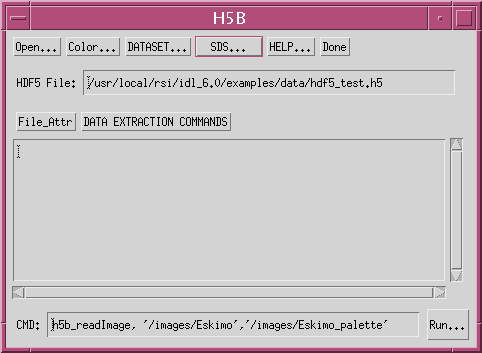
Open... - popup HDF5 file selection dialog, default file types include: '*.h5*', '*.nx*','*.Nx*' Color... - popup IDL load color table program DATASET... - popup the dataset display sub-program for the picked hdf5 file SDS... - popup the SDS selection dialog for the picked hdf5 file Help... - display the on line help about main window Done - exit h5b program HDF5 File: - text field for displaying current hdf5 picked File_Attr - find and display the file attributes in the scroll text area DATA EXTRACTION COMMANDS - display syntax of data extraction command in the scroll text area Scroll Text Area - text area display file attribute or command syntax CMD: - text field for entering data extraction command, default extract the 'Eskimo' image from hdf5_test.h5 Run... - accept the CMD syntax and extract it from the selected filename
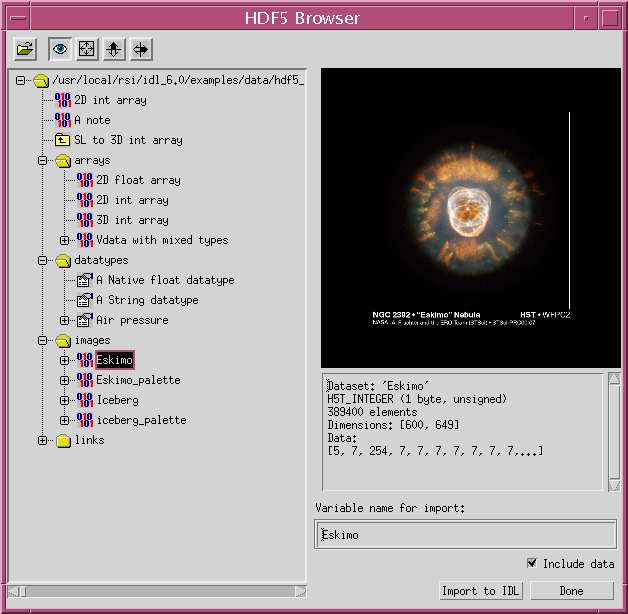
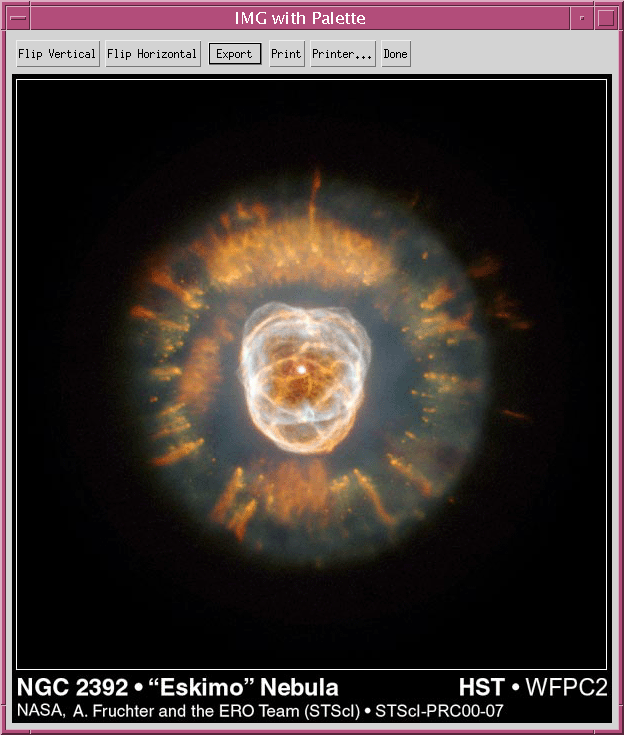
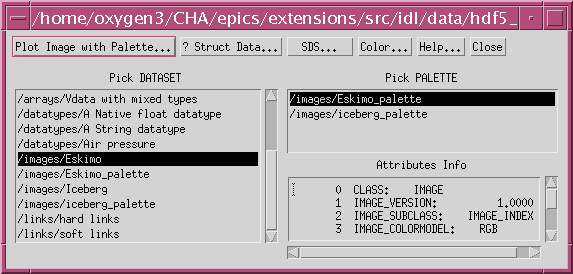
Plot Image with Palette...When an image data comes with a palette data, this button can be used to plot the true image data. Before press this button make sure that an image name is picked from DATASET list, and a palette name is picked from the PALETTE list. In order to make this work properly, the palette data name in HDF5 file must always contain '_palette' in its dataset name as shown in this sample example.
? Struct Data...This button allows the user to query and display the group structure of the selected dataset.
SDS...This button pops up the SDS selection dialog which provides various features of accessing the HDF5 SDS data found in the opened file.
Color...This button calls the IDL xloadct subprogram, it allows the user to load any IDL supplied color tables.
Help...This button display the on-line help about this window.
CloseThis button close this window dialog.
Pick DATASETThis selection list contains the complete set of DATASETs found in the opened HDF5. Each DATASET can contains data or sub-groups. If a data is picked, the corresponding data plot sub-program pops up. If a sub-group is picked, a new child DATASET window pops up. If there is attribute found for the selected DATASET or sub-group it will be displayed in the Attributes Info text area.
Pick PALETTEThis selection list contains the palette data name found in the opened HDF5. For the default test sample there are two palette data: '/images/Eskimo_palette', and '/images/iceberg_palette'.
Attributes InfoThis scrolled text area displays the attributes found for the selected DATASET.
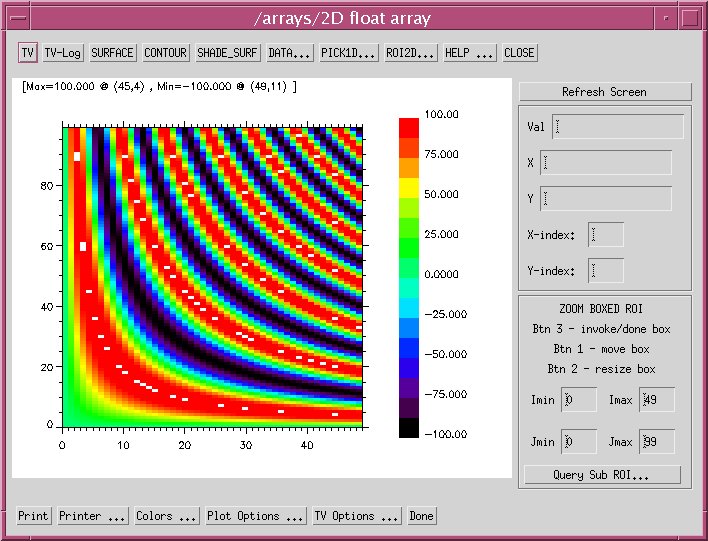
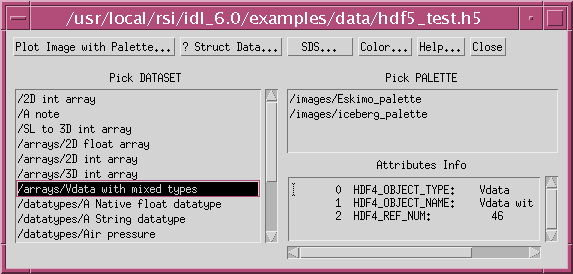
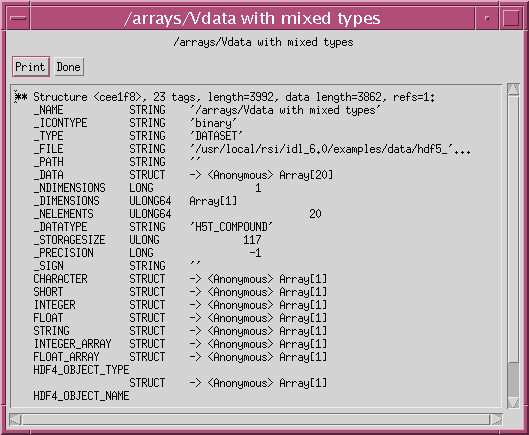
First window shows the item '/images/Iceberg' is selected from the DATASET list, because a 2D image data is extracted, therefore PLOT2D is called.
Second, a '/images/iceberg_palette' is selected from the PALETTE list, as shown in the second window.
Last the 'Plot Image with Palette...' button is pressed, then the PLOT2D_IMAGE is called and the last window pops up.


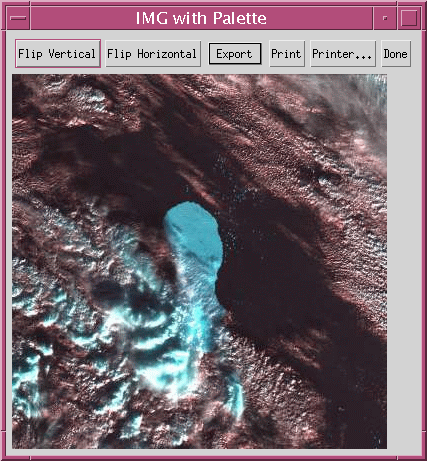
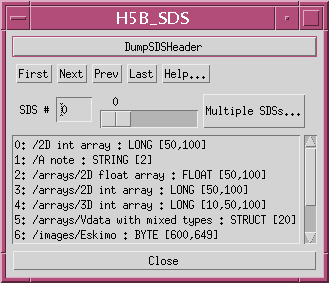
DumpSDSHeader - display header of all dataset First - display the first dataset Next - display the Next dataset Prev - display the Previous dataset Last - display the last dataset SDS # - display the seq number of selected dataset Slider - pick the seq number for desired dataset Multiple SDSs... - dialog for multiple SDSs selection Dataset Nameist - a complete dataset selection list Close - close the selection dialogPress the 'DumpSDSHeader' button pops up the following display window. It displays header about all the dataset found in the opened file. For each dataset set the name, type, dimension, and first 6 items are displayed.
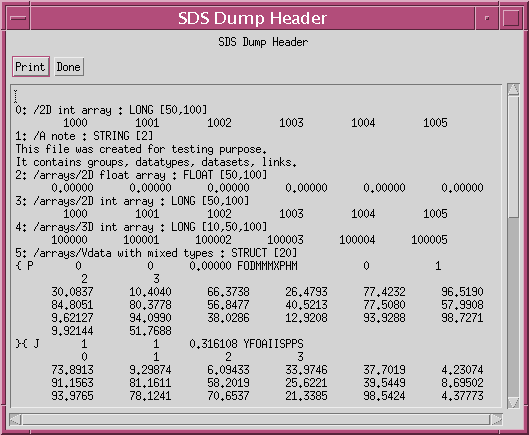

In this example a 2D sequence number '0,2,3' are entered, and the 'IMAGE2D...' button is pressed. The PANIMAGE and IMAGE2D windows pops up they are displayed below.

The '/arrays/2D float array' is picked in the following IMAGE2D window.
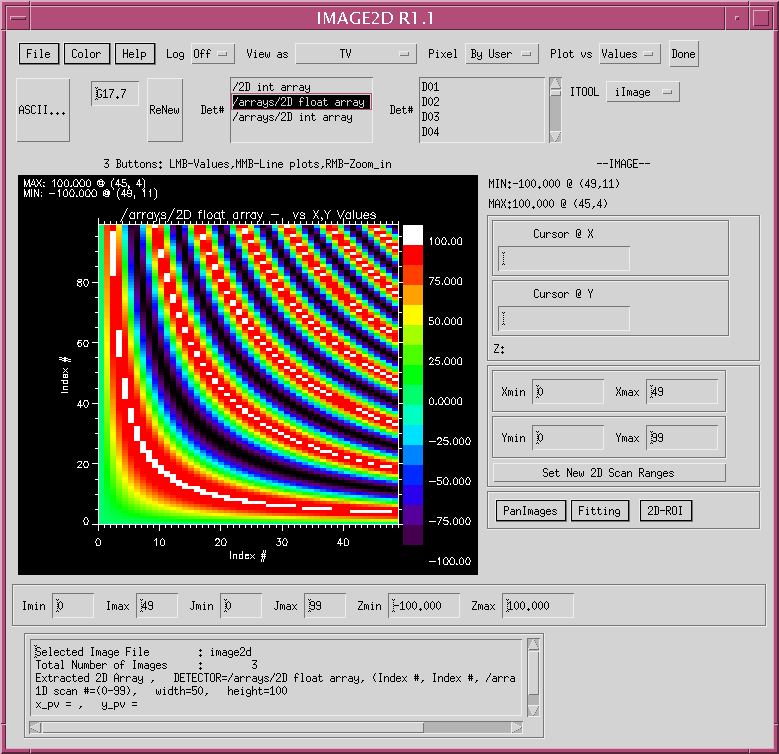
h5b,file=file
This command run the widget program h5b.pro with the specified file name.
h5b_readImage,name,name_p,file=file
This command extracts the an image data with color palette from the specified file.
name - a string to specify the full dataset name
name_p - a string to specify the full palette name
file - specify the from HDF5 file name
h5b_readArray,name,file=file,data=data,readonly=readonly
This command extracts the data array from the specified dataset and file.
name - a string to specify the full dataset name
file - specify the from HDF5 file name
data - return the data array extracted from the dataset
readonly - if specified no raw data graph is displayed
h5b_dialogPick,file=file
This command pops up the group/dataset selection dialog for the specified file.
h5b_sds,file=file
This command pops up the H5B_SDS selection dialog for the specified file.
h5b_attrs,file,st
This command finds and returns file attruibute array from the specified file.
file - specify the from HDF5 file name
st - return string attribute array
h5b_dattrs,gname,st,file=file
This command finds and returns dataset attruibute array from the specified name and file.
gname - a string to specify the full dataset name
file - specify the from HDF5 file name
st - return string attribute array
h5b_dNames,dnames,name=name,gnames=gnames,SDS=SDS,file=file,debug=debug
This command returns dataset names found from the specified name and file.
file - specify the from HDF5 file name
name - a string to specify the input group dataset name, default '/'
dnames - return dataset names found for the specified dataset name
gname - return subgroup names found for the specified dataset name
SDS - return only SDS dataset names for the specified dataset name
debug - echo the gnames,dnames,SDS results obtained
h5b_getStruct,name,file=file,data=data
This command extracts a data structure from the specified file.
name - a string to specify the full dataset name
file - specify the from HDF5 file name
data - return a structured dataset varible
h5b_plot,varname,pn=pn
This command plots 1D/2D/3D data array extracted from the imported dataset variable.
varname - imported hdf5 dataset variable name, either by h5_browser
or by h5b_getStruct command.
pn - specify the hdf5 varible name imported from the color
palette name, either by h5_browser or by h5b_getStruct command